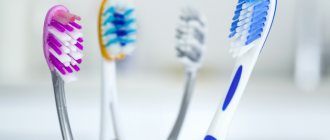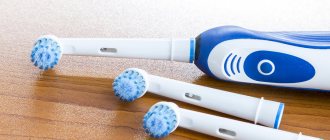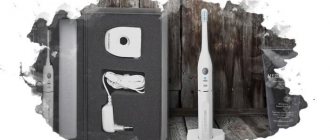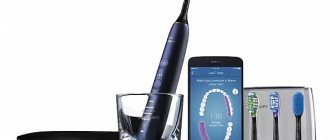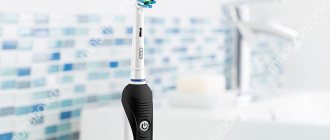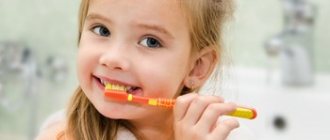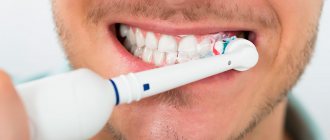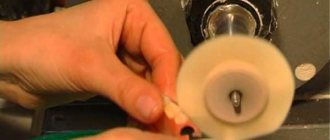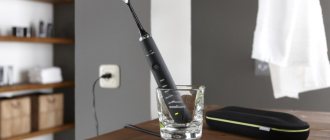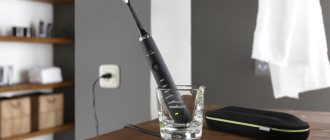- Electric or manual toothbrushes
- Recommendations for choosing a children's electric brush
- How does a brush motivate you to brush your teeth?
Do you want your child to have healthy teeth and gums and visit the dentist’s office less often?
Instill in him the healthy habit of brushing his teeth regularly. In 2014, the World Health Organization (WHO) announced global statistics on dental diseases. According to it, almost 100% of adults and 60–90% of children have caries.
The main risk factors include poor diet and poor oral hygiene. As a preventative measure, WHO recommends reducing the amount of sugar in your diet, including more fruits and vegetables, and maintaining good oral hygiene.
Seems simple? But instilling in your child the habit of brushing their teeth twice a day is not such an easy task. To solve it, you need to interest the baby by turning hygiene into a game. A children's toothbrush should not only be safe, but also interesting.
Peculiarities
The special thing about an electric toothbrush is that its bristles vibrate. Therefore, you do not need to make an effort to clean all your teeth well. The bristles of the brush move up and down or in a circle, effectively removing plaque and food particles from between teeth.
This device consists of a handle with a motor inside, a power source and a barrel on which a removable head is attached. Unlike adult toothbrushes, which are used by all family members, children's toothbrushes are different. They have the following features:
- operate at low speed;
- they are smaller and lighter;
- the handle is shorter;
- decorated colorfully, often in the form of fairy-tale characters;
- the head has the shape of a corolla;
- the villi are short and very soft, but elastic.
Attention! If a child wears braces, the shape of the head should be different: the bristles are arranged in one bunch to make it easier to clean the space between them and the teeth.
| Name | Age limit | Type | Prices RUR |
| From 1 year | |||
| CS Medica CS-561 Kids | from 1 year to 5 years | sound | from 611 to 1693 |
| Hapica Baby | from 1 year to 6 years | sound | from 1340 to 1890 |
| From 3 years | |||
| Oral-B Pro 500 + Stages Power Frozen | from 3 years old | standard | from 3410 to 5790 |
| Oral-B Pro 500 + Stages Power Star Wars | from 3 years old | standard | from 3410 to 4098 |
| Hapica Kids | from 3 to 10 years | sound | from 1209 to 1890 |
| Oral-B Kids Mickey Mouse | from 3 years | standard | from 1700 to 3590 |
| Philips Sonicare For Kids HX6322/04 | from 3 years | sound | from 4830 to 6788 |
| Oral-B Smart 4 | from 3 years old | standard | from 4340 to 11990 |
| Oral-B Stages Power Frozen Elsa, Anna, Olaf D12.513K | from 3 years old | standard | from 1174 to 4990 |
| From 4 years | |||
| Soocas C1 | from 4 years old | sound | from 2079 to 2990 |
| From 5 years | |||
| CS Medica CS-461 Kids | from 5 to 12 years | standard | from 300 to 1162 |
| CS Medica CS-562 Junior | from 5 years old | sound | from 792 to 1490 |
| FOREO ISSA mini 2 | from 5 years old | sound | from 8990 to 9999 |
| CS Medica CS-462 Kids | from 5 to 12 years | standard | from 614 to 890 |
| From 6 years | |||
| Oral-B Stages Power Star Wars D12.513K | from 6 years | standard | from 2650 to 5500 |
| Oral-B Junior | from 6 years | standard | from 2650 to 5500 |
| Oral-B Smart 4 Junior Sensi | from 6 years old | standard | from 4290 to 7990 |
| From 7 years | |||
| Philips Sonicare For Kids HX6311/07 | from 7 years | sound | from 3170 to 5491 |
Kinds
Dentists recommend starting to brush your baby's teeth when they just start to erupt. And at 2-3 years old he can already buy an electric toothbrush. There are many different models on sale, parents are often confused. They may differ in the principle of action and type of movement. In addition, children's toothbrushes vary in the age of the child and the softness of the bristles.
According to the operating principle
All electric toothbrushes are powered by a motor. But their operating principle may be different.
- Standard models are the most affordable. They have a round head that can rotate at different speeds and in different directions. They gently cleanse teeth without damaging gums.
- Sonic ones work due to sound waves, which cause the fibers to vibrate and whip up foam from the paste. They better clean plaque, bacteria and food debris from all hard-to-reach places. This option is recommended for a child who wears a plate or braces.
- Ultrasonic models work on the same principle, only at higher sound vibrations. They are considered the most effective, since ultrasound destroys even hard plaque. Not recommended for use by children before teeth change. They are used mainly to remove tartar and darkening of teeth.
By type of movement
Brushes also differ in the type of head movement. It can rotate or pulsate, that is, move back and forth. There are also models that combine these functions, which increases cleaning efficiency.
- With a brush with a rotating head, teeth are cleaned by moving the bristles in a circle. Usually the head does not rotate in one direction, but back and forth. For a child, you need to choose a brush with a low rotation speed, this will prevent injury.
- More effective models are those in which the head not only rotates, but also vibrates. It cleans better and damages your gums less.
- In pulsating brushes, the bristles produce forward movements, due to which they penetrate between the teeth. They soften and remove plaque better.
Tips for choosing
Choosing an electric toothbrush for a child is in many ways similar to choosing a toothbrush for an adult. It is worth remembering that there are only two types of brushes for children: standard and sonic. The former are equipped with soft bristles, while the latter may seem unusual to the child due to the noise.
Consider the speed of movement of the bristles: the higher it is, the more intense the cleaning. Accordingly, for the little ones it is worth choosing brushes with less vibration.
Also, for the little ones and for those who use a brush for the first time, the habituation function to the brush may be useful, as well as the built-in pressure sensor on the teeth.
Synchronization with a smartphone is suitable for kids who have yet to learn how to brush their teeth properly.
Advantages
When mechanically brushing your teeth, you need to make certain movements with the brush. To clean all dental surfaces you need to work for at least 2 minutes. Children often don't like this. And the main advantage of an electric toothbrush is that the correct movements are programmed into it; you just need to move it along the dentition. This process attracts the baby, turning oral care into an interesting game.
Such devices also have other advantages:
- provide complete oral care with minimal effort;
- thoroughly clean the interdental spaces, which a child cannot do with a regular brush;
- prevent the development of caries;
- can be used without toothpaste
Attention! A child familiar with an electric toothbrush is less afraid of dental treatment.
How to teach your child self-hygiene
It is best that adults, by personal example, introduce their son or daughter to self-care from early childhood and show that it is pleasant and useful. Oral hygiene should be carried out in the form of role-playing games, using your favorite toys. As a rule, children willingly copy the behavior of their parents if they want to show off their size and take part in something interesting.
It is important to know! Do not force or intimidate your child into brushing their teeth. Do not try to get him to perform all manipulations regularly and within a strictly allotted time from the first days. This approach will discourage you from picking up a brush and toothpaste for a long time, and the procedure itself will be associated only with negativity.
Terms of use
Children under 5-7 years old must use such devices under adult supervision. First, the parents themselves brush the baby’s teeth, then they just stay nearby.
The cleaning process differs from the usual mechanical one. You need to place the rotating head on one area at an angle of 45˚. Hold it without pressing for 10 seconds, then move it a little. It is necessary to pay attention to all surfaces, not forgetting the chewing, distant teeth, from the inside.
Attention! Children are recommended to use this brush no more than 2 times a week.
Good and bad brushes. How to distinguish them?
First, study the case. What material is it made of? If it is cheap Chinese plastic, with backlashes and gaps, an unpleasant chemical smell, etc., we immediately reject this option.
The second point is the bristles. Children's teeth are much more sensitive than adults. This is due to the fact that the level of enamel mineralization is still very low. Therefore, it is necessary that the brush does not damage it.
At the same time, too soft bristles will be useless. It is not able to remove plaque particles from the surface of the teeth. Therefore, such cleaning will not remove plaque. Over time, this will lead to logical consequences - caries.
Useful features
Such devices have various useful functions. It is best to use them after 7 years of age; children need to learn how to simply brush their teeth. Useful features may include:
- It’s good if the brush has a timer that will help the child brush his teeth as much as needed;
- a pressure sensor is required; it is triggered when the child presses the head hard against the teeth;
- The gum massage mode is useful, which improves blood circulation;
- There may be different replaceable attachments: for sensitive gums, cleaning interdental spaces, gentle cleaning.
Simple moves. Nozzle operation
Brushes with a motor have three options for movements made by the nozzle:
- 1D – normal rotation;
- 2D – instead of circular movements, reciprocating movements are performed. This is much more effective.
- 3D – combining reciprocating action and pulsation. This method of cleaning teeth is considered more effective in removing plaque.
Selection of nozzles
Some models are equipped with several different attachments. For others, add-on kits may be sold, such as electric floss, attachments for sensitive teeth, or for deep cleaning. It is very convenient when there is a good choice for the chosen model.
It is believed that the optimal height of the bristles should not exceed 10 mm. Ideally, the presence of bristles of different heights.
Popular brands
Children's electric brushes are produced by many companies. But you need to give preference to proven well-known brands. They engage in research and implement new technologies, so they produce high-quality products.
Oral-B
The most popular models are produced under this brand. They are easy to use, inexpensive, and have a timer that teaches your baby to brush their teeth for a certain time. All brushes are beautifully designed and have a comfortable non-slip handle.
Philips
The brushes are produced with a bright design, the handle is decorated with drawings of your favorite cartoon characters. The head is oval, standard size. The devices have a timer, a cleaning mode, and Bluetooth.
CS Medica
The company has developed a bright design especially for children. The operating principle is based on sound vibrations. Can be used from 2-3 years. Has backlight, timer, low weight.
Hapika
This Japanese brand produces different models for children from 3 years old. They have a small head with soft, rounded bristles. Hapika brushes create sound vibrations that gently clean children's teeth. They are light and do not make much noise.
Basic user mistakes
Both children and adults make mistakes when using an electric toothbrush. This:
- Imitates the movements that occur when brushing your teeth with a regular brush. The electric version copes with this task on its own; you just need to press it against the tooth enamel.
- Strong pressure. There are models on sale that emit a beep when you press too hard; during the period of adaptation, you can give preference to them.
- Incomplete coverage of the tooth with bristles.
The device must be stored in an upright position without a sealed lid - it is intended for transportation during travel. For rinsing, do not use boiling water or too hot water (more than 40 degrees). Synthetic bristles cannot withstand high temperatures; if they come into contact with boiling water, the attachment will become unusable. In all other respects, the device is unpretentious and does not require complex cleaning procedures.
How to choose
The child needs to purchase a separate brush, specially made for children. In addition, when choosing, you need to pay attention to several parameters:
- It is better to have a charge indicator, then the device will not turn off unexpectedly;
- the child does not need many modes and additional functions;
- the handle should be comfortable and non-slip.
From one year to 3 years
Dentists recommend purchasing such a brush for a child as early as 2-3 years old, when all the teeth have grown. Another condition for its effective use is that the baby should not be afraid of the buzzing sound that it makes when working. When choosing, you need to pay attention to the labeling; the age must be indicated. A brush for such a baby should be small, light, with soft bristles. This can be recognized by the inscription extra soft.
From 3 years to 5 years
Typically, it is at this age that a child is first given an electric toothbrush. It will make it easier to get him used to brushing his teeth, as it will be perceived as a game. It is recommended to choose standard models with a small head and soft bristles; they will be marked extra soft.
From 5 years to 7 years
At this age, the child begins to use this brush more often. It may be larger in size, but still brightly decorated. You need to choose a soft head, the inscription will be soft.
From 7 years
Children over 7 years old are allowed to use these brushes independently. They no longer have to choose very bright models, since they are used to caring for their oral cavity every day. But the brush should still be light, with a soft head.
What to look for when choosing
The stiffness of the bristles
As already mentioned, children's teeth are more vulnerable to decay than those of adults. Milky enamel is more fragile because contains less calcium and phosphorus. And the natural process of remineralization often fails due to the large number of harmful foods in the diet, this must be taken into account. That's why electric brushes for babies are distinguished by soft and fine bristles, so that cleaning is as gentle as possible.
Good to know! If you already have an “adult” brush at home with a gentle cleaning mode, when the device works without pulsating, it will be quite suitable for a child over 7 years old. Of course, you will need to buy a separate attachment that is suitable for the baby in terms of softness and size.
2. Equipment - nozzles, operating modes and sensors
Electronic hygiene products can be programmed to operate in multiple modes and come with multiple attachments for different purposes. For example, the kit may include a head for massaging the gums, cleansing the tongue and cheeks. The most useful functions for such a device are a pressure sensor and a timer that measures the cherished 2 minutes of cleaning. They will help control the procedure time and prevent damage to sensitive enamel.
“Since my son started brushing with an electric brush, his teeth have become much whiter, and the plaque on his gums no longer accumulates in the same amount. And he himself became much more interested in using such a fashionable gadget. And the built-in timer is just a godsend for kids. It works every 30 seconds, changing the vibration frequency. So it becomes clear that it’s time to clean another area.”
Miura, review from irecommend.ru
3. Please pay attention to age restrictions
When buying an electric brush, you need to make sure that its characteristics are optimal for the baby’s age. The packaging usually states what age category the device is intended for: from 3, 5, 6 or 7 years old.
Electric brush power method
Which gadget to buy—battery-powered or rechargeable—is another important question. The first ones operate on one power source for up to three months, then the battery will have to be replaced. The device with the battery is charged from the network. Energy lasts for an average week.
Availability of a mobile application
Children over 5 years old will be delighted with the brush with the option of synchronizing with a smartphone. A special application is installed on the phone, through which the little researcher can track his progress and receive valuable advice on improving his skills.
Reviews
Parents' reviews of such devices are positive. They especially often note that it was easier for the baby to get used to oral care and brushing his teeth no longer causes problems.
Olga
I bought electric brushes for my twin children when they were 5 years old. On the advice of the dentist, I chose Oral-B. The kids liked them, now they brush their teeth without reminders. The growing molars are white and clean, there is no caries.
Marina
I bought Oral-B for my daughter when she was 3.5 years old. At first she was scared by the buzzing, but then she got used to it. Now he loves his brush and brushes his teeth with pleasure.
Dmitriy
I was choosing a quality brush for my son and settled on CS Medica. It was decorated beautifully, the child liked the robots. And I’m pleased that it cleans well and is convenient to use.
Electric toothbrushes help accustom your child to the unpleasant procedure of brushing teeth. If you choose the right model, it will carefully remove plaque, protect against caries and reduce toothpaste consumption.
Correct holding and application
Choose a device so that its handle fits comfortably in a child’s palm and does not slip. Discuss with your child what the brush “can do” and how it works. Then learn how to hold it. Watch the training video together. Videos with cartoon characters, funny characters, or kids the same age as the main characters will come in very handy. Show how to move the brush correctly in the mouth, explain that you need to spend time on each tooth - this is important.
On a note! You can learn more about how to properly brush your teeth with an electric brush from another thematic material.
Children aged 5 years and older can easily cope with the task themselves, but mothers and fathers should still keep an eye on the baby. It will be great if joint oral hygiene becomes a family tradition.
Dentists' opinion
View this post on Instagram
Save so you don’t lose, and don’t forget about ❤️

